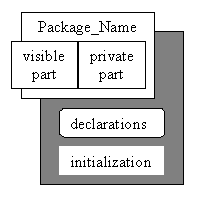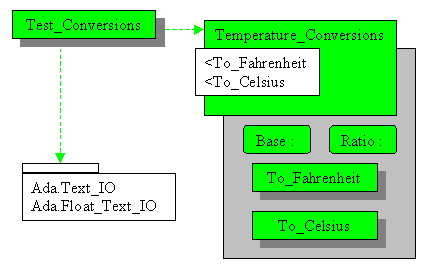[ Table of Contents ] [ Prev ] [ Chapter Overview ] [ Next ] [ Glossary/Index ]
The following table depicts the general form of a package, which has two parts: a declaration and a body. Note that the package
declaration always includes three reserved words (package, is, end), and
the package body always includes four reserved words (package, body, is, end).
The left-hand column of the table shows how a graphic symbol for a package may be expanded
to represent its various parts, some of which are optional. For example, the declaration
always contains a visible part, but the private part is optional.
Expanded Symbol |
General Form of a package |

|
package Package_Name is
-- visible declarations
private -- (optional)
-- private declarations (optional)
end Package_Name;
--------------------------------------------
package body Package_Name is
-- declarations
begin -- (optional)
-- initialization statements -- (optional)
end Package_Name;
|
Package Specification
Some texts refer to the first part of a package as its specification or "spec" for
short. Actually, the declaration is the specification plus the final semi-colon.
Example Program with a User-defined Package
| This diagram depicts the program listed below, including a package that
exports two functions. Some details of the body of package Temperature_Conversions are
also shown.. Note the symbols (round-cornered rectangles) used to represent the
declarations of Base and Ratio, which are constant floating point values. We use this graphic symbol to represent any type or object declaration.
We include the colon inside the symbol to indicate that the element declared is a variable
or constant object. Without the colon the symbol depicts the declaration of a type or
subtype -- or just a collection of declarations. |

|
The next table provides a listing of the Temperature_Conversions package and the two
exported functions, To_Fahrenheit and To_Celsius. The two functions are declared in the
package declaration, making them available to clients, and they are implemented in the
package body. (Both functions are nested units
that were created using the two-step form of nesting discussed earlier.) Now that
Test_Conversions has "withed in" the Temperature_Conversions package, the scope of the package as well as the two functions
exported by it has been enlarged to include the Test_Conversions main procedure. The main
procedure also includes three variable
declarations.
Example package declaration (no private part) |
package Temperature_Conversions is
function To_Fahrenheit (C : Float) return Float;
function To_Celsius (F : Float) return Float;
end Temperature_Conversions;
|
Example package body
(initialization not needed)
|
package body Temperature_Conversions is
Base : constant Float := 32.0;
Ratio : constant Float := 1.8;
-------------------------------------------------
function To_Fahrenheit (C : Float) return Float is
begin
return Base + Ratio*C;
end To_Fahrenheit;
-------------------------------------------------
function To_Celsius(F : Float) return Float is
begin
return (F - Base)/Ratio;
end To_Celsius;
-------------------------------------------------
end Temperature_Conversions;
|
A procedure to test the temperature conversions
package
|
--------------------------------------------------
-- This procedure sets up a loop, allowing the
-- user to input values in 'F' or 'C' and have
-- them converted to Celsius or Fahrenheit,
-- respectively. When the user chooses 'Q' or 'q',
-- the program quits.
--------------------------------------------------
with Temperature_Conversions;
with Ad.Text_IO, Ada.Float_Text_IO;
procedure Test_Conversions is
package Tcv renames Temperature_Conversions;
package Tio renames Ada.Text_IO;
package Fio renames Ada.Float_Text_IO;
Input : Float;
Result : Float;
Choice : Character;
begin
loop
Tio.Put_Line("Enter F, C or Q");
Tio.Get(Choice);
exit when (Choice = 'Q') or (Choice = 'q');
if (Choice = 'F') or (Choice = 'f') then
Tio.Put_Line("Enter a Fahrenheit value");
Fio.Get(Input);
Result := Tcv.To_Celsius(Input);
Tio.Put("In Celsius that is ");
elsif (Choice = 'C') or (Choice = 'c') then
Tio.Put_Line("Enter a Celsius value");
Fio.Get(Input);
Result := Tcv.To_Fahrenheit(Input);
Tio.Put("In Fahrenheit that is ");
end if;
Fio.Put(Result);
Tio.New_Line;
end loop;
end Test_Conversions;
|
Two different Get procedures appear above, one
exported by Ada.Text_IO and the other exported by Ada.Float_Text_IO. Actually, Ada.Text_IO
exports two versions of Get -- an example of overloading
a name in the same unit -- one version gets a character and the other version gets a
string. The compiler knows which version to call because the actual parameter, Choice, has
been declared to be of type Character.
Here is a sample output from the above program:
Enter F, C or Q
c
Enter a Celsius value
20.0
In Fahrenheit that is 6.80000E+01
Enter F, C or Q
f
Enter a Fahrenheit value
60.0
In Celsius that is 1.55555E+01
Enter F, C or Q
q
|
Initialization During Elaboration
The (optional) executable part of a
package plays a different role from that of a subprogram. During elaboration of the package the declarations
are elaborated first, and then the executable part (if any) is used as an initialization sequence. All library
packages are elaborated before the main procedure is entered.
The next page continues our discussion of packages and their uses.
Related Topics
[ Back to top of page ] [ Prev ] [ Next ]

